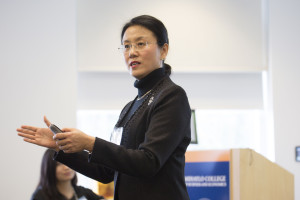Few people in the world could probably offer the sort of perspective on China’s developing insurance industry as economist Qixiang Sun.
Sun is the dean of the school of economics at Peking University, and director of the China Center for Insurance and Social Security Research. The list of her authoritative links to China’s insurance industry goes on and on.
Sun spoke to a group of insurance professionals on Wednesday at Cal State Fullerton University, kicking off the first of many planned global risk management virtual classroom sessions to be hosted by the school’s Center for Insurance Studies.
According to Weili Lu, the center’s director, the plan is to have risk management experts from around the world come to the university to talk about the state of insurance in their country. The center is part of the Mihaylo College of Business and Economics, which has more than 8,000 students enrolled and is considered the largest business college west of the Mississippi.
Sun described China’s insurance industry as “very much backward” compared with the rest of the world, but also noted its rapid growth and the great potential for those companies willing to deal with a little extra regulation.
China now ranks among the top five countries in terms of premium income. Roughly $688.66 billion in non-life premium was written in 2015, up from $402.69 billion in 2010, according to Sun.

Photo courtesy of the Center for Insurance Studies at Cal State Fullerton University
While the insurance business in China has grown, it’s still only ranks 49th in terms of insurance penetration, she said. According to her, China’s penetration, measured by premium vs. gross domestic product, is 3.2 percent.
That’s little more than half the world average of 6.2 percent, she said, pointing China’s potential for growth.
Despite that gap, the number of property insurance companies currently operating in China is now at 49, up from 36 in 2010. There are 47 life insurance companies, three reinsurance companies and 20 asset management companies.
Property insurance is one of the largest lines in China with a roughly 38 percent share. Life insurance is the top line at roughly 53 percent, followed by health insurance at 7 percent and casualty at 2 percent.
One reason for the low interest in casualty may be cultural, as people tend to settle disputes on their own, and the nation’s legal system differs from the U.S., with fewer lawsuits filed, Sun said.
For some background, Sun offered a history of insurance in her country, which she said dates back much farther than most people probably know.
According to her, the first insurance company in China was the British East India Co., which began operating in Guangzhou in 1805. In 1949 the People’s Insurance Company of China was established, however in 1959 the industry was shut down because of its association with capitalism.
Insurance was brought back to China in 1979, and in 1992 the industry was opened up to competition from foreign companies and AIG became the first foreign insurer to operate in the country, Sun said.
When China’s insurance market opened up to the outside world in 1992, the worry was that domestic insurers would get swept aside by foreign competition, Sun said.
But that didn’t happen. In fact, most insurance in China is written by domestic insurers.
Foreign insurers accounted for 2.03 percent of non-life premiums in 2015, however that’s up from 1.06 percent in 2010, according to Sun.
“The trend is increasing,” she added.
Reasons why more foreign insurers aren’t writing insurance in China are numerous. Among those reasons are that foreign insurers seem to be more risk adverse, and they move slower because they often operate through subsidiaries, Sun said.
“The decision-making process is a little bit slower than Chinese companies,” she added.
However, even domestic competition for insurance business is dominated by a few big players.
In terms of assets China Life tops all insurers at 26 percent. That company is followed by Ping An Insurance (12 percent) and China Pacific Group (8 percent). Those companies are all partly owned by the state.
All other insurers in China combined account for 33 percent of assets.
“Foreign companies are only 6 percent in terms of assets,” Sun said.
Another reason foreign insurers aren’t more prevalent in China could be due to the stringent requirements to start up there.
The China Insurance Regulatory Commission has a list of requirements for various types of insurance businesses to open in the country. Depending on how a company is structured, those requirements include having been in business 20 years or longer, having total assets of $2 billion, as well as applications and waiting periods. In the case of joint ventures, the commission requires at least a 50 percent stake from domestic companies.
Something China does have in common with the U.S. and Europe is the growing interest in online distribution of insurance.
Before 2015 there was only one online insurance company operating in China, but by July of last year three new companies were preparing to distribute insurance online, and several Internet firms, such as Alibaba Group, had applied for licenses to distribute insurance, Sun said.
Topics California Carriers Education China Market Universities
Was this article valuable?
Here are more articles you may enjoy.


 Former Congressman Charged After Collision with State Trooper in Florida
Former Congressman Charged After Collision with State Trooper in Florida  Wildfires Are Upending Some of the Safest Bets on Wall Street
Wildfires Are Upending Some of the Safest Bets on Wall Street  FBI Says Chinese Hackers Preparing to Attack US Infrastructure
FBI Says Chinese Hackers Preparing to Attack US Infrastructure  Coral Gables, Florida Tops Beverly Hills as Ritziest Home Market in US
Coral Gables, Florida Tops Beverly Hills as Ritziest Home Market in US 

